The global eco-friendly inks market is valued at USD 4.2 billion in 2025 and is set to reach USD 8.9 billion by 2035, recording an absolute increase of USD 4.7 billion over the forecast period. This translates into a total growth of 111.9%, with the market forecast to expand at a CAGR of 7.8% between 2025 and 2035. The market size is expected to grow by approximately 2.1X during the same period, supported by increasing demand for environmentally responsible printing solutions, growing regulatory compliance requirements, rising adoption of green printing technologies, and expanding requirements for non-toxic ink formulations across commercial printing, packaging, and publishing sectors.
Between 2025 and 2030, the eco-friendly inks market is projected to expand from USD 4.2 billion to USD 6.1 billion, resulting in a value increase of USD 1.9 billion, which represents 40.4% of the total forecast growth for the decade. This phase of development will be shaped by increasing demand for biodegradable ink formulations, rising awareness of environmental printing standards, and growing availability of plant-based ink alternatives across commercial printing operations and specialty packaging applications.
Between 2030 and 2035, the market is forecast to grow from USD 6.1 billion to USD 8.9 billion, adding another USD 2.8 billion, which constitutes 59.6% of the ten-year expansion. This period is expected to be characterized by the advancement of bio-based ink technologies, the integration of renewable raw material sources, and the development of premium eco-friendly formulations across diverse printing categories. The growing emphasis on carbon footprint reduction and environmental compliance will drive demand for advanced ink varieties with enhanced performance properties, improved color consistency features, and superior functionality characteristics.
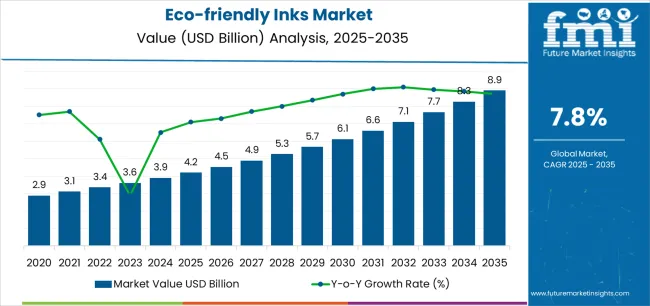
| Metric | Value |
|---|---|
| Estimated Market Value (2025E) | USD 4.2 Billion |
| Forecast Market Value (2035F) | USD 8.9 Billion |
| Forecast CAGR (2025-2035) | 7.8% |
From 2030 to 2035, the market is forecast to grow from USD 6.1 billion to USD 8.9 billion, adding another USD 2.8 billion, which constitutes 59.6% of the ten-year expansion. This period is expected to be characterized by the advancement of plant-based ink technologies, the integration of renewable solvent systems for high-performance applications, and the development of specialized ink formulations for digital printing formats. The growing emphasis on print quality excellence and environmental positioning will drive demand for sophisticated varieties with enhanced color vibrancy, improved adhesion characteristics, and superior performance features.
Between 2020 and 2024, the eco-friendly inks market experienced significant growth, driven by increasing awareness of environmental benefits and growing recognition of green ink systems' effectiveness in supporting efficient printing operations across commercial and packaging segments. The market developed as users recognized the potential for eco-friendly inks to deliver economic advantages while meeting modern requirements for minimal environmental impact and reliable printing practices. Technological advancement in formulation chemistry and ink engineering began emphasizing the critical importance of maintaining color accuracy while extending print durability and improving user experience across diverse printing applications.
Market expansion is being supported by the increasing global demand for environmentally responsible printing solutions and the corresponding shift toward green ink formulations that can provide superior print quality while meeting user requirements for reduced environmental impact and toxin-free printing processes. Modern businesses are increasingly focused on incorporating ink systems that can enhance brand reputation while satisfying demands for consistent, reliably performing mechanisms and optimized printing practices. Eco-friendly inks' proven ability to deliver vibrant colors, extended print life, and diverse application possibilities makes them essential printing components for commercial printers and quality-conscious publishing operations.
The growing emphasis on environmental consciousness and regulatory compliance is driving demand for high-performance eco-friendly ink systems that can support green positioning and comprehensive environmental benefits across packaging products, commercial printing services, and publishing product categories. User preference for ink mechanisms that combine functional excellence with environmental responsibility is creating opportunities for innovative implementations in both traditional and emerging printing applications. The rising influence of environmental regulations and modern green printing infrastructure is also contributing to increased adoption of eco-friendly inks that can provide reliable performance and consistent quality characteristics.
The market is segmented by ink type, printing technology, application, end-use industry, and region. By ink type, the market is divided into water-based inks, soy-based inks, UV-curable inks, vegetable oil-based inks, and bio-based inks. Based on printing technology, the market is categorized into offset printing, flexographic printing, digital printing, screen printing, and gravure printing. By application, the market includes packaging, publishing, commercial printing, labels, and textile printing. By end-use industry, the market encompasses food & beverage, pharmaceuticals, cosmetics, automotive, and other industries. Regionally, the market is divided into North America, Europe, Asia Pacific, Latin America, Middle East & Africa, and other regions.
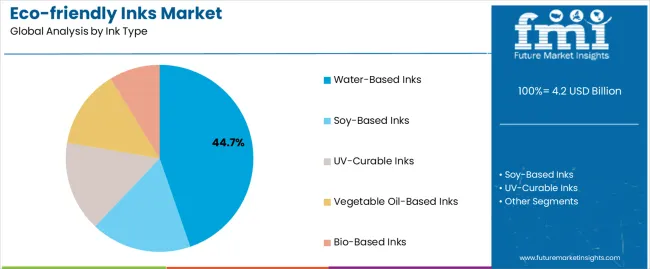
The water-based inks segment is projected to account for 44.7% of the eco-friendly inks market in 2025, reaffirming its position as the leading ink category. Businesses and printing facilities increasingly utilize water-based inks for their superior environmental characteristics, established cost-effectiveness, and essential functionality in diverse printing applications across multiple substrate types. Water-based inks' standardized performance characteristics and proven reliability directly address user requirements for consistent print quality and optimal environmental value in commercial applications.
This ink segment forms the foundation of modern eco-friendly printing patterns, as it represents the format with the greatest commercial versatility and established compatibility across multiple printing technologies. Business investments in formulation refinement and quality standardization continue to strengthen adoption among performance-conscious operators. With users prioritizing low VOC emissions and environmental compliance, water-based inks align with both functional objectives and environmental requirements, making them the central component of comprehensive green printing strategies.
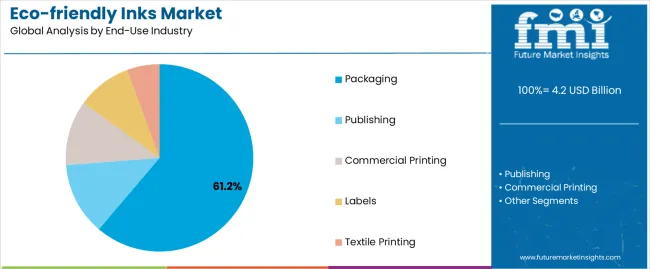
Packaging is projected to represent 61.2% of the eco-friendly inks market in 2025, underscoring its critical role as the primary application for efficiency-focused businesses seeking superior printing benefits and enhanced environmental credentials. Commercial users and packaging brands prefer eco-friendly ink applications for their established high-volume positioning, proven operational acceptance, and ability to maintain exceptional print profiles while supporting diverse packaging formats during various production experiences. Positioned as essential applications for discerning operators, packaging offerings provide both operational efficiency excellence and environmental advantages.
The segment is supported by continuous improvement in ink technology and the widespread availability of customization options that enable brand distinction and premium positioning at the consumer level. Ink companies are optimizing formulations to support print quality and accessible production strategies. As ink technology continues to advance and consumers seek environmentally responsible packaging formats, packaging applications will continue to drive market growth while supporting operational efficiency and environmental compliance strategies.
The eco-friendly inks market is advancing rapidly due to increasing environmental regulations and growing need for compliance mechanisms that emphasize superior print quality outcomes across commercial segments and packaging applications. The market faces challenges, including complexity in formulation development, compatibility issues with certain printing technologies, and cost pressures affecting premium ink adoption. Innovation in bio-based ink systems and advanced formulation technologies continues to influence market development and expansion patterns.
The growing adoption of eco-friendly inks in regulatory compliance printing is enabling businesses to develop production patterns that provide distinctive environmental benefits while commanding consumer confidence and enhanced regulatory approval. Compliance applications provide superior environmental properties while allowing more sophisticated certification features across various printing categories. Users are increasingly recognizing the functional advantages of eco-friendly ink positioning for regulatory printing and efficiency-conscious compliance integration.
Modern eco-friendly ink manufacturers are incorporating advanced bio-based technologies, renewable formulation concepts, and plant-derived material systems to enhance environmental responsibility, improve performance characteristics, and meet commercial demands for reduced environmental impact. These systems improve resource effectiveness while enabling new applications, including carbon-neutral programs and green printing solutions. Advanced bio-based integration also allows manufacturers to support circular economy positioning and environmental objectives beyond traditional printing operations.
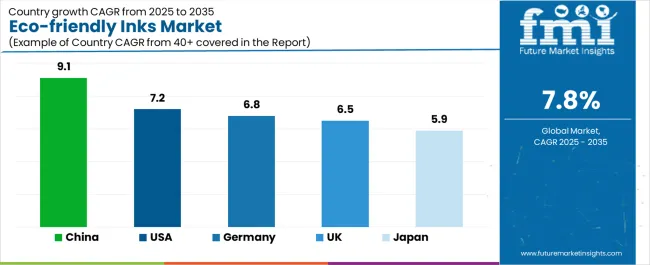
| Country | CAGR (2025-2035) |
|---|---|
| USA | 7.2% |
| Germany | 6.8% |
| UK | 6.5% |
| China | 9.1% |
| Japan | 5.9% |
The eco-friendly inks market is experiencing robust growth globally, with China leading at a 9.1% CAGR through 2035, driven by the expanding packaging industry, growing environmental regulations, and increasing adoption of green printing technologies. The USA follows at 7.2%, supported by rising regulatory compliance demand, expanding commercial printing applications, and growing acceptance of innovative ink solutions. Germany shows growth at 6.8%, emphasizing established printing capabilities and comprehensive environmental innovation. The UK records 6.5%, focusing on premium eco-friendly printing and publishing sophistication. Japan demonstrates 5.9% growth, prioritizing quality ink solutions and technological precision.
The report covers an in-depth analysis of 40+ countries, with top-performing countries highlighted below.
Revenue from eco-friendly ink consumption and sales in the USA is projected to exhibit exceptional growth with a CAGR of 7.2% through 2035, driven by the country's rapidly expanding commercial printing sector, favorable regulatory attitudes toward environmental printing, and initiatives promoting innovative ink mechanisms across major printing regions. The USA's position as a leading commercial printing market and increasing focus on compliance-conscious printing development are creating substantial demand for high-quality eco-friendly inks in both commercial and specialty markets. Major printing companies and ink producers are establishing comprehensive printing capabilities to serve growing demand and emerging market opportunities.
Demand for eco-friendly ink products in Germany is expanding at a CAGR of 6.8%, supported by rising printing sophistication, growing environmental requirements, and expanding manufacturing infrastructure. The country's developing technical capabilities and increasing commercial investment in precision engineering are driving demand for eco-friendly inks across both imported and domestically produced applications. International ink companies and domestic manufacturers are establishing comprehensive operational networks to address growing market demand for quality printing inks and efficient environmental solutions.
Revenue from eco-friendly ink products in the UK is projected to grow at a CAGR of 6.5% through 2035, supported by the country's mature publishing market, established printing culture, and leadership in environmental printing aesthetics. Britain's sophisticated consumer base and strong support for premium environmental printing are creating steady demand for both traditional and innovative eco-friendly ink varieties. Leading publishing brands and specialty manufacturers are establishing comprehensive operational strategies to serve both domestic markets and growing export opportunities.
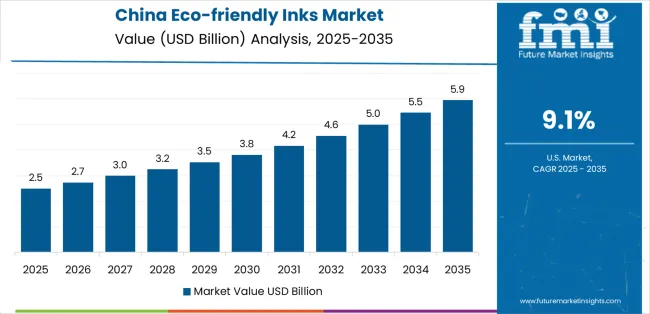
Demand for eco-friendly ink products in China is anticipated to expand at a CAGR of 9.1% through 2035, driven by the country's emphasis on packaging expansion, manufacturing leadership, and sophisticated production capabilities for inks requiring specialized precision varieties. Chinese manufacturers and printing brands consistently seek commercial-grade inks that enhance print quality and support printing operations for both traditional and innovative consumer applications. The country's position as an Asian manufacturing leader continues to drive innovation in specialty eco-friendly ink applications and commercial production standards.
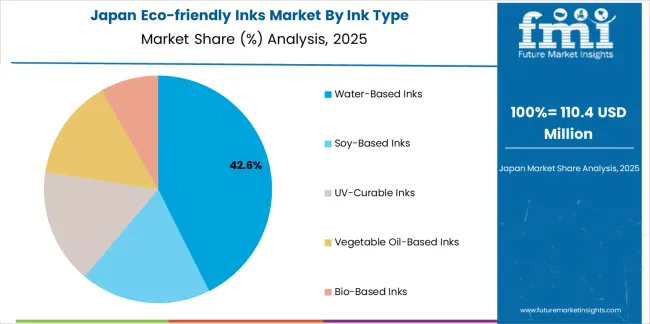
Revenue from eco-friendly ink products in Japan is expected to grow at a CAGR of 5.9% through 2035, supported by the country's emphasis on quality manufacturing, printing precision, and advanced technology integration requiring efficient ink solutions. Japanese businesses and printing brands prioritize ink reliability and manufacturing precision, making eco-friendly inks essential printing components for both traditional and modern printing applications. The country's comprehensive quality excellence and advancing printing patterns support continued market expansion.
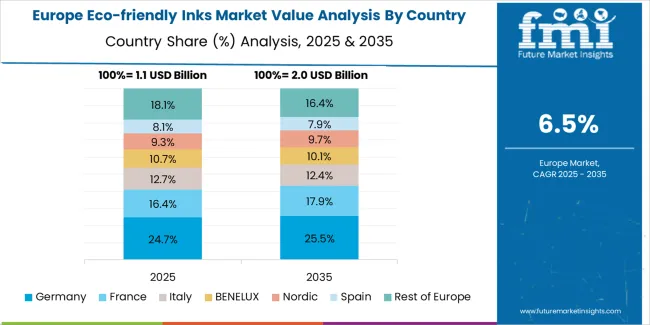
The Europe eco-friendly inks market is projected to grow from USD 1.4 billion in 2025 to USD 2.9 billion by 2035, recording a CAGR of 7.6% over the forecast period. Germany leads the region with a 35.2% share in 2025, moderating slightly to 34.8% by 2035, supported by its strong manufacturing base and demand for premium, technically advanced ink products. The United Kingdom follows with 21.8% in 2025, easing to 21.4% by 2035, driven by a sophisticated publishing market and emphasis on environmental printing innovation and design excellence. France accounts for 16.7% in 2025, rising to 17.1% by 2035, reflecting steady adoption of premium printing solutions and commercial printing innovation. Italy holds 12.3% in 2025, expanding to 12.7% by 2035 as packaging innovation and specialty ink applications grow. Spain contributes 7.5% in 2025, growing to 8.0% by 2035, supported by expanding printing sector and premium environmental printing. The Nordic countries rise from 4.2% in 2025 to 4.5% by 2035 on the back of strong environmental adoption and advanced printing technologies. BENELUX declines from 2.3% in 2025 to 1.5% by 2035, reflecting market maturity and regional consolidation.
The eco-friendly inks market is characterized by competition among established ink manufacturers, specialized environmental ink producers, and integrated printing solution companies. Companies are investing in precision formulation technologies, advanced performance enhancement systems, product innovation capabilities, and comprehensive customization networks to deliver consistent, high-quality, and reliable eco-friendly ink systems. Innovation in bio-based technology, low-VOC materials, and application-specific product development is central to strengthening market position and customer satisfaction.
Sun Chemical Corporation leads the market with a strong focus on ink innovation and comprehensive printing solutions, offering commercial ink systems with emphasis on engineering excellence and environmental heritage. Flint Group provides specialized printing ink capabilities with a focus on global market applications and formulation engineering networks. Siegwerk Druckfarben AG delivers integrated printing solutions with a focus on ink positioning and operational efficiency. Toyo Ink Group specializes in comprehensive printing ink solutions with an emphasis on commercial applications. INX International Ink Co. focuses on comprehensive printing and packaging inks with advanced design and premium positioning capabilities.
The success of eco-friendly ink systems in meeting commercial printing demands, consumer-driven environmental requirements, and performance integration will not only enhance printing delivery outcomes but also strengthen global ink manufacturing capabilities. It will consolidate emerging regions' positions as hubs for efficient ink production and align advanced economies with commercial printing systems. This calls for a concerted effort by all stakeholders -- governments, industry bodies, manufacturers, distributors, and investors. Each can be a crucial enabler in preparing the market for its next phase of growth.
| Item | Value |
|---|---|
| Quantitative Units (2025) | USD 4.2 billion |
| Ink Type | Water-Based Inks; Soy-Based Inks; UV-Curable Inks; Vegetable Oil-Based Inks; Bio-Based Inks |
| Printing Technology | Offset Printing; Flexographic Printing; Digital Printing; Screen Printing; Gravure Printing |
| Application | Packaging; Publishing; Commercial Printing; Labels; Textile Printing |
| End-Use Industry | Food & Beverage; Pharmaceuticals; Cosmetics; Automotive; Other Industries |
| Regions | North America; Europe; Asia Pacific; Latin America; Middle East & Africa; Other Regions |
| Key Countries | United States; Germany; United Kingdom; China; Japan; and 40+ additional countries |
| Key Companies | Sun Chemical Corporation; Flint Group; Siegwerk Druckfarben AG; Toyo Ink Group (profiled); INX International Ink Co.; Other leading eco-friendly ink companies |
| Additional Attributes | Dollar sales by ink type, printing technology, application & end-use industry; Regional demand trends; Competitive landscape; Technological advancements in ink engineering; Bio-based technology integration initiatives; Low-VOC ink programs; Premium product development strategies |
The global eco-friendly inks market is estimated to be valued at USD 4.2 billion in 2025.
The market size for the eco-friendly inks market is projected to reach USD 8.9 billion by 2035.
The eco-friendly inks market is expected to grow at a 7.8% CAGR between 2025 and 2035.
The key product types in eco-friendly inks market are water-based inks , soy-based inks, uv-curable inks, vegetable oil-based inks and bio-based inks.
In terms of end-use industry, packaging segment to command 61.2% share in the eco-friendly inks market in 2025.






Full Research Suite comprises of:
Market outlook & trends analysis
Interviews & case studies
Strategic recommendations
Vendor profiles & capabilities analysis
5-year forecasts
8 regions and 60+ country-level data splits
Market segment data splits
12 months of continuous data updates
DELIVERED AS:
PDF EXCEL ONLINE
Understanding Eco-Friendly Inks Market Share Trends
Hand Sinks Market - Hygiene & Compliance in Foodservice 2025 to 2035
Soft Drinks Packaging Market Size and Share Forecast Outlook 2025 to 2035
Soft Drinks Concentrates Market Trends - Growth & Forecast
Beauty Drinks Market Size and Share Forecast Outlook 2025 to 2035
Organic Drinks Market Size and Share Forecast Outlook 2025 to 2035
Low Fat Drinks Market Size and Share Forecast Outlook 2025 to 2035
Underbar Sinks Market - Space-Saving & Functional Bar Solutions 2025 to 2035
Conductive Inks Market Size and Share Forecast Outlook 2025 to 2035
Cannabis Drinks Market Size and Share Forecast Outlook 2025 to 2035
Collagen Drinks Market Analysis - Size, Share, and Forecast Outlook 2025 to 2035
Decorative Inks Market Analysis by Application and Region Through 2035
Understanding Market Share Trends in Conductive Inks
Breakfast Drinks Market Size and Share Forecast Outlook 2025 to 2035
Alcoholic Drinks Packaging Market Size and Share Forecast Outlook 2025 to 2035
Water-based Inks Market Size and Share Forecast Outlook 2025 to 2035
Water-Borne Inks and Paints Market Growth - Trends & Forecast 2025 to 2035
Janitorial Sinks Market Growth - Trends & Forecast 2025 to 2035
Aloe Vera Drinks Market Outlook – Growth, Size & Demand 2025-2035
Compartment Sinks Market - Hygiene & Efficient Kitchen Workflow 2025 to 2035

Thank you!
You will receive an email from our Business Development Manager. Please be sure to check your SPAM/JUNK folder too.
Chat With
MaRIA